Ichiba Castle
-Being fired by refusal of transfer-
Overview
Name: Ichiba castle (Ichiba-jo)
Alias:
Place: Ichiba-cho Toyota city, Aichi
Location: 35.22829086875775, 137.2947995674477
Type: Mountain Castle
Built: 16th century
Remaining remnants: Stone walls, clay walls and dry moats
Title:
Ichiba castle (市場城) is located at a hill of Obara village, in the north part of Toyota city. Obara area places at the north border of Mikawa province (eastern part of Aichi prefecture), and a road connects Okazaki plain including Okazaki city or Toyota city and middle part of Mino province runs through this area. Because of this geographical region, Ichiba castle worked not only as a residence of local lord but also a border base against Mino province.
Precise year is unknown but it is said that Ichiba castle was built at the beginning of 16th century by local lord Suzuki clan. Suzuki clan is said as a descendent of Kumano naval force, and had been a retainer of Suzuki clan which governed Asuke area. Originally Suzuki clan resided at Ichiba Kojyo (Ichiba old castle) at the east of Ichiba castle, but later built new castle at higher place and moved.
Suzuki clan lived Ichiba castle over 80 years and governed this area. It might be thought they once belonged to Imagawa clan at the middle of 16th century, but after the rise of Ieyasu Tokugawa (1543-1616), Suzuki clan followed to Ieyasu. Suzuki clan at Asuke castle was involved in the conflict between Ieyasu and Takeda clan, but this Ichiba clan simply kept as a retainer of Tokugawa clan. Shigeyoshi Suzuki (?-?), leader of the clan, made achievement at the battle of Takatenjin castle and increased territory.
In the middle of 1580's, Shigeyoshi reformed Ichiba castle using modern technology such as stone walls or combined gate (Masugata). Obara area was a border to Mino province, but originally Mino province had been one of the main region of Nobunaga Oda (1534-1582), a firm ally of Ieyasu, and there was no need to secure this border. But after the death of Nobunaga at the incident of Honnoji in 1582, under confused situation Ieyasu had to guard this border.
Later Mino province was controlled by next ruler Hideyoshi Toyotomi (1537-1598), and Ieyasu once rejected attack by Hideyoshi at the battle of Komaki Nagakute in 1584 and made peace, but continuously secure this area. Ichiba castle is too large and secure as a castle of small lord, and it is thought Tokugawa clan supported the reform of this castle.
Ichiba castle spread over a long and narrow hill spread northward and southward. Central area is a long and narrow gourd shaped area of 100 meter long, and south wall of the area which faced main route from hillside was guarded by three layer stone walls. Upper layer of this stone wall was restored one, but lower two layer keep the shape of original build. The corner of this walls was processed with Sangi-dumi (pile up of rectangular stones with different angle), which was advanced technology of later 1580's.
Two ridges used as secondary area and third area spread westward from the north and south edge of central area, thus the shape of main area is a reverse C letter style. The valley inside this C letter is called as "Sanza-batake", and thought to be used as a residence of important retainer.
Outer corridor surrounds whole part of this central area, and the backside of the castle at the east of central area a large area was prepared digging the slope. The east edge of the castle was guarded by clay walls, and backside gate of this castle places at this direction.
Type: Mountain Castle
Built: 16th century
Remaining remnants: Stone walls, clay walls and dry moats
Title:
Brief History
Ichiba castle (市場城) is located at a hill of Obara village, in the north part of Toyota city. Obara area places at the north border of Mikawa province (eastern part of Aichi prefecture), and a road connects Okazaki plain including Okazaki city or Toyota city and middle part of Mino province runs through this area. Because of this geographical region, Ichiba castle worked not only as a residence of local lord but also a border base against Mino province.
Origin of Suzuki clan and Ichiba castle
Precise year is unknown but it is said that Ichiba castle was built at the beginning of 16th century by local lord Suzuki clan. Suzuki clan is said as a descendent of Kumano naval force, and had been a retainer of Suzuki clan which governed Asuke area. Originally Suzuki clan resided at Ichiba Kojyo (Ichiba old castle) at the east of Ichiba castle, but later built new castle at higher place and moved.
Suzuki clan lived Ichiba castle over 80 years and governed this area. It might be thought they once belonged to Imagawa clan at the middle of 16th century, but after the rise of Ieyasu Tokugawa (1543-1616), Suzuki clan followed to Ieyasu. Suzuki clan at Asuke castle was involved in the conflict between Ieyasu and Takeda clan, but this Ichiba clan simply kept as a retainer of Tokugawa clan. Shigeyoshi Suzuki (?-?), leader of the clan, made achievement at the battle of Takatenjin castle and increased territory.
In the middle of 1580's, Shigeyoshi reformed Ichiba castle using modern technology such as stone walls or combined gate (Masugata). Obara area was a border to Mino province, but originally Mino province had been one of the main region of Nobunaga Oda (1534-1582), a firm ally of Ieyasu, and there was no need to secure this border. But after the death of Nobunaga at the incident of Honnoji in 1582, under confused situation Ieyasu had to guard this border.
Later Mino province was controlled by next ruler Hideyoshi Toyotomi (1537-1598), and Ieyasu once rejected attack by Hideyoshi at the battle of Komaki Nagakute in 1584 and made peace, but continuously secure this area. Ichiba castle is too large and secure as a castle of small lord, and it is thought Tokugawa clan supported the reform of this castle.
Structure of Ichiba castle
Ichiba castle spread over a long and narrow hill spread northward and southward. Central area is a long and narrow gourd shaped area of 100 meter long, and south wall of the area which faced main route from hillside was guarded by three layer stone walls. Upper layer of this stone wall was restored one, but lower two layer keep the shape of original build. The corner of this walls was processed with Sangi-dumi (pile up of rectangular stones with different angle), which was advanced technology of later 1580's.
Two ridges used as secondary area and third area spread westward from the north and south edge of central area, thus the shape of main area is a reverse C letter style. The valley inside this C letter is called as "Sanza-batake", and thought to be used as a residence of important retainer.
Outer corridor surrounds whole part of this central area, and the backside of the castle at the east of central area a large area was prepared digging the slope. The east edge of the castle was guarded by clay walls, and backside gate of this castle places at this direction.
At northwest slope there is a line of vertical moats, which is often used by Takeda clan castles but an only one example in Aichi prefecture. At east edge of the castle, there is a combined gate guarded by stone wall clearly later added. Total size of the castle is about 200 meter square, and size of each area is larger than other medieval mountain castles.
In 1590, after Odawara campaign against Hojo clan, Ieyasu Tokugawa was transferred to Kanto region by Hideyoshi Toyotomi. At this time Shigeyoshi Suzuki might be told to move to Kanto region along with Tokugawa clan, but Suzuki clan refused this order and chose to stay their territory.
Expulsion by refusal of transfer
In 1590, after Odawara campaign against Hojo clan, Ieyasu Tokugawa was transferred to Kanto region by Hideyoshi Toyotomi. At this time Shigeyoshi Suzuki might be told to move to Kanto region along with Tokugawa clan, but Suzuki clan refused this order and chose to stay their territory.
But soon after that Suzuki clan was confiscated its territory and expelled, and Shigeyoshi died lonely after wandering. In Japan denaial of transfer usually means cold treatment from employer, and this kind of things happened from 400 years agto. Ichiba castle was also abolished at this time and later was destructed.
Now castle site is prepared as a historical site and a path was built around the castle. Even though a small castle in mountainous area, this castle has interesting elements such as usage of stone wall, combined gate or vertical moats. Being disposed under the process of evolution into modern castle, mixture of medieval and modern element gives strange character to this castle not seen in neighbor castles.
30 minutes drive from Tokai-Kanjo Expressway Sanage-Fujioka interchange or Sanage Green-Road Sanage-Higashi interchange via Route 419.
Now castle site is prepared as a historical site and a path was built around the castle. Even though a small castle in mountainous area, this castle has interesting elements such as usage of stone wall, combined gate or vertical moats. Being disposed under the process of evolution into modern castle, mixture of medieval and modern element gives strange character to this castle not seen in neighbor castles.
Access
30 minutes drive from Tokai-Kanjo Expressway Sanage-Fujioka interchange or Sanage Green-Road Sanage-Higashi interchange via Route 419.












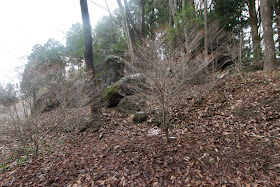












































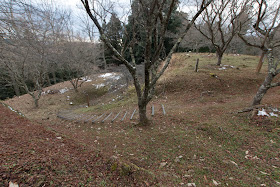


































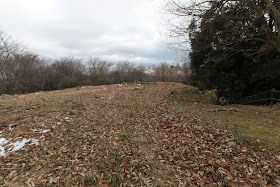



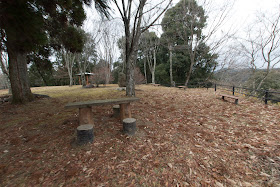










































































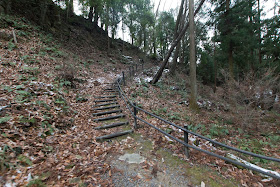





























































No comments:
Post a Comment